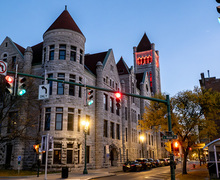Fawning over: Professor, students present findings on Syracuse’s deer population
Natalie Riess | Art Director
After conducting extensive research, a SUNY-ESF professor handed Syracuse residents the hard truth about the city’s problematic white-tailed deer.
Brian Underwood, an adjunct associate professor in the Department of Environmental and Forest Biology at the State University of New York College of Environmental Science and Forestry, presented his research on the white-tailed deer population in the East Side of Syracuse on Tuesday at Nottingham High School.
Underwood said he and two of his students gave a presentation to provide the facts behind the deer problem in Syracuse.
The main point shown was that the distribution of deer in Syracuse is not uniform, Underwood said. Deer can be mostly found in and around the green spaces in the environment, he said, such as cemeteries, parks and institutional campuses.
Underwood and his students documented a large sample of deer in the northeast part of Syracuse’s East Side, he said. They found the highest concentration of the animals in the St. Mary Cemetery.
The current deer population in Syracuse is estimated to be about 218, with 19 deer per square mile, Underwood said. He added that people think these numbers have increased over the past few years but there is no data to support that.
The presentation showed that he counted the deer along roadsides from April 2013 through October 2013 and conducted snow track surveys from December 2013 to March.
“As part of a larger study to understand the causes for the expansion of deer populations in urban areas, we estimated the deer population size and distribution in the East Side communities,” Underwood said in his presentation.
In these green spaces, Underwood and his students identified approximately 40 suitable daytime resting areas for the deer and the winter track counts confirmed that a lot of deer were using these areas, according to the presentation.
Syracuse residents have raised concerns about issues that can be caused by deer overpopulation, including Lyme disease, deer automobile accidents and effects on the land and people’s property, he said. Underwood added that there is always a concern for the effects of deer eating native plants.
Underwood said a lot of the decisions on how to handle problems caused by the deer are personal, such as how people manage their yards and landscapes and how they interact with the deer.
The next level of dealing with deer is managing the problem on a large scale, he said, adding that the decisions have to be made collectively and everybody must agree on a particular course of action.
“You need to find the money to pull it off and then have the fortitude to follow through,” Underwood said.
The city of Syracuse is genuinely concerned about the issues caused by the deer, Underwood said. They are concerned for the citizens’ safety and well-being and are onboard to see what they can do to resolve the issues.
Sophia Pevzner, a senior wildlife science major, has been involved with Underwood’s work with deer for the past two years and has collected all of the winter data for him. She said the Syracuse Police Department doesn’t keep data as far as deer-vehicle accidents, but they know that cars have hit many animals.
“There are a lot of possible solutions,” she said. “First, we need to know what we’re dealing with, and then it depends on what the community decides to do.”
Pevzner also said one of the city council officials issued a statement saying that the community is putting together a commission to try to analyze the issue. The commission is called Tomorrow’s Neighborhoods Today and will look at different solutions to the problems posed by the deer, she said.
Published on April 14, 2014 at 1:47 am





